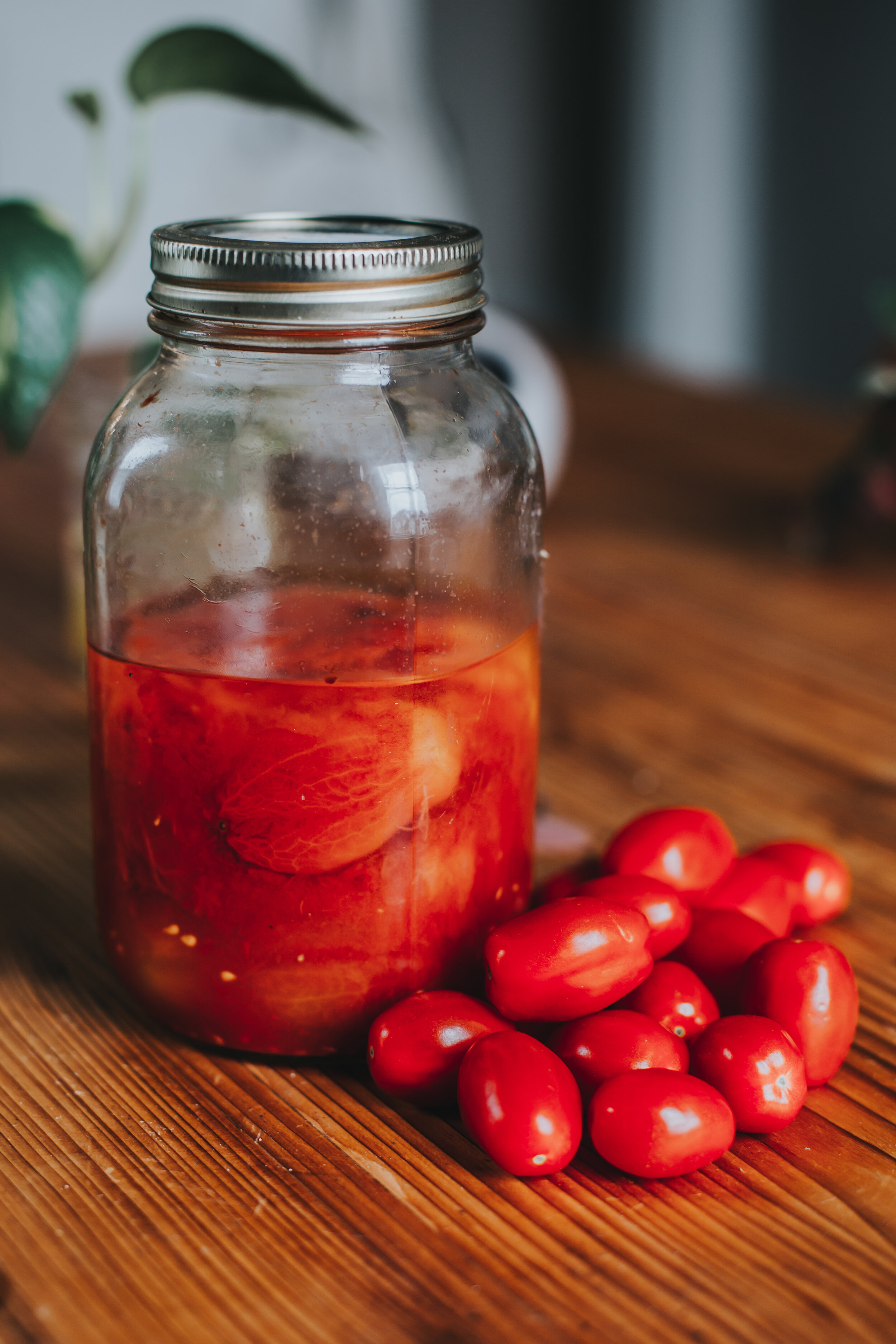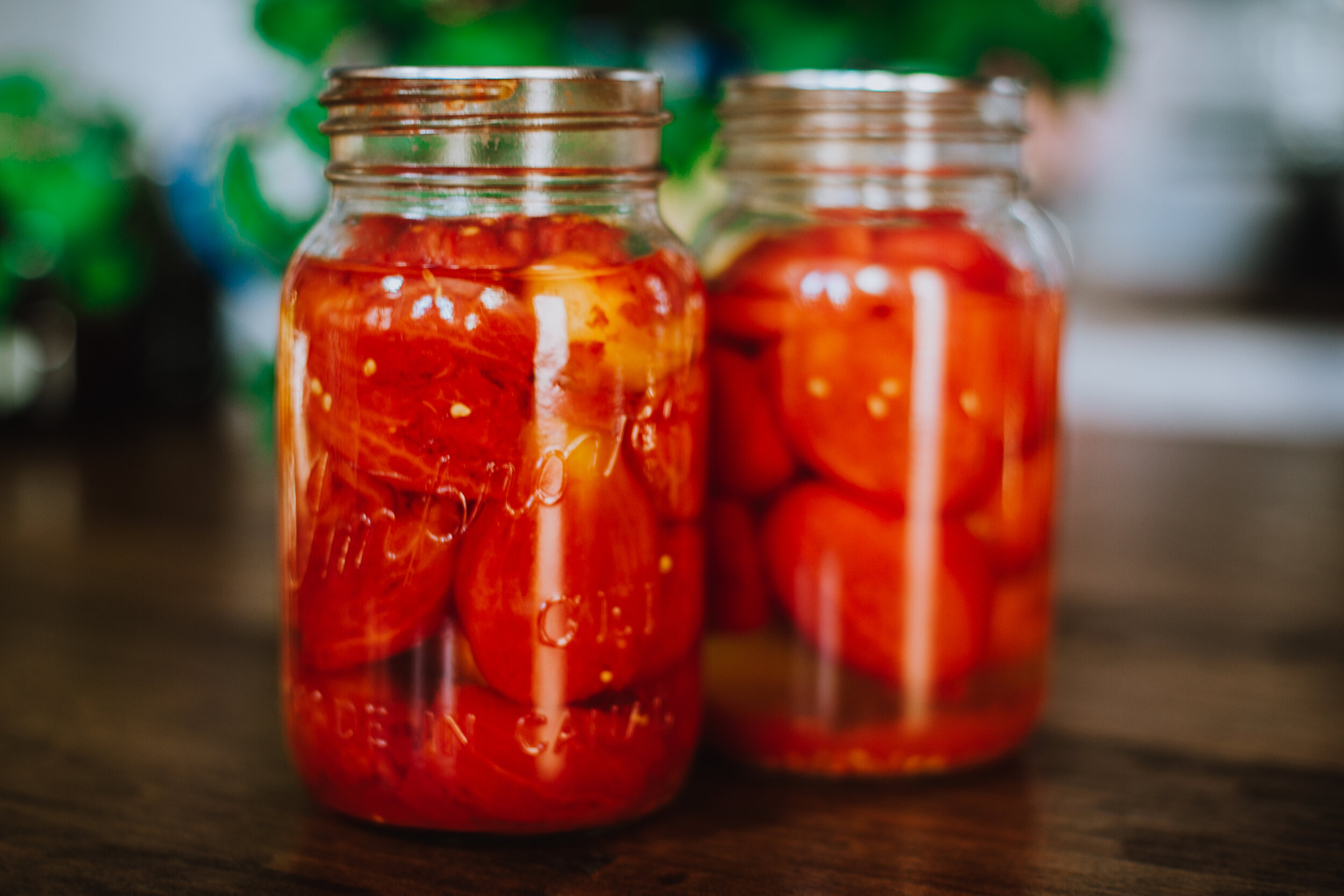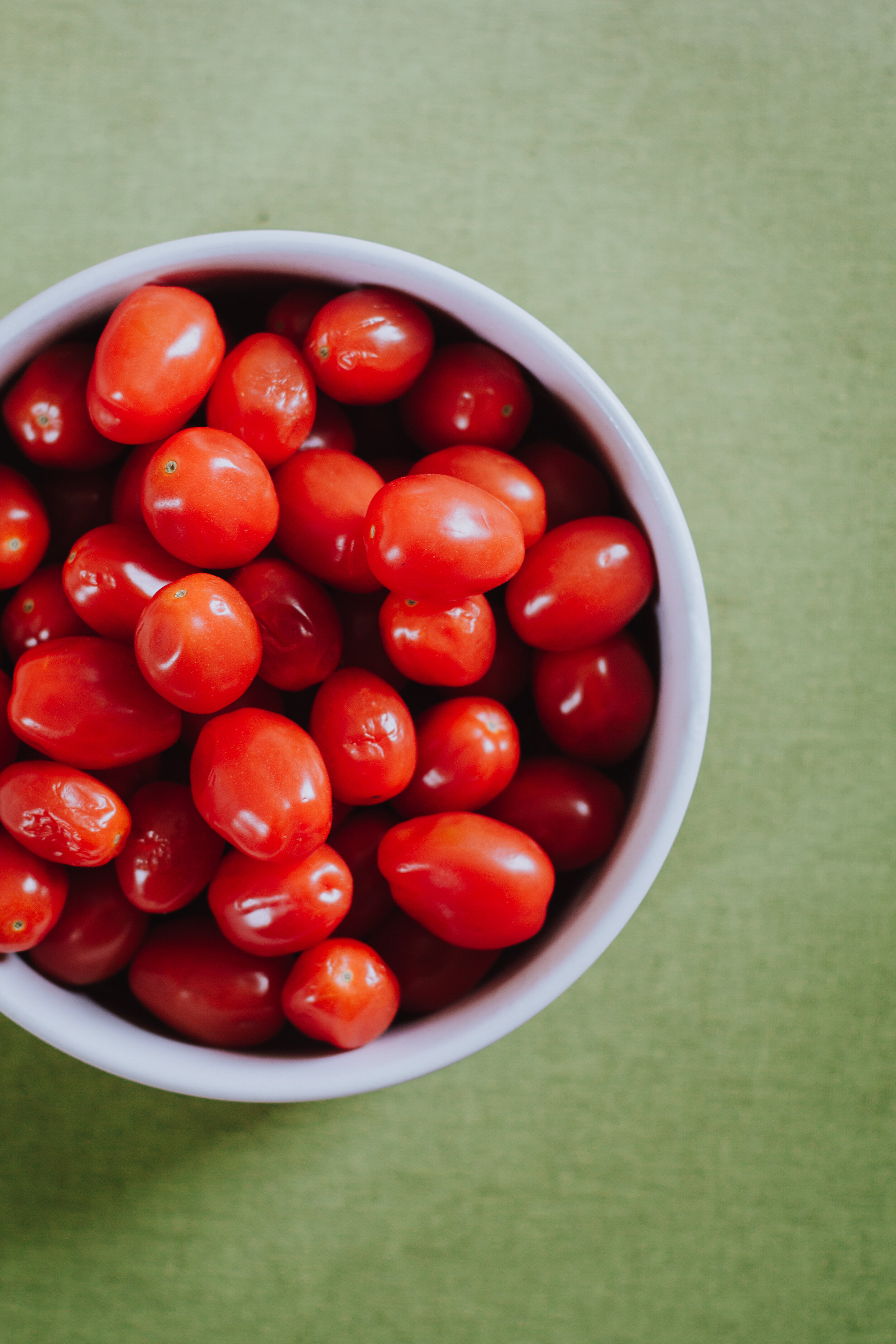Tomatoes
WHole/Halved | Stewed | paste | Juice
I could go on and on about tomatoes. I mean, they are one of the most versatile and much-used fruits (yes, fruits) available to the home canner. Every year, I process in excess of 150 lbs of tomatoes. I make canned whole tomatoes, stewed tomatoes, tomato paste, tomato sauce, tomato juice, salsa and pizza sauce (do I sound like Bubba from Forrest Gump about his shrimp?). I also make tomato-based pasta sauces including roasted marinara sauce, meaty Bolognese sauce and even vodka sauce. This year, I also decided to try ratatouille sauce and cacciatore sauce. I made tomato curry jam and for the first time, I made tandoori tomato jam. I’m looking forward to adding these special jams to my festive charcuterie boards this Christmas. Now you understand why I say tomatoes are so versatile. Think about all of the full jars sitting in the cellar waiting for that quick winter meal. Growing (or even buying) tomatoes in bulk at the local Farmer’s Market can be so cost effective, plus the flavour is far superior to those available in the stores in the winter months.
Canned Whole or Halved Tomatoes
Yield 7 quarts (litres)
Ingredients
22 lbs ripe tomatoes (about 10 medium tomatoes per quart)
14 Tbsp bottled lemon juice
7 tsp salt
Water
Directions for Raw Packing with Water
Place water in boiling water canner. Heat to a simmer. Place 7 clean, warm 1 quart mason jars on a rack in canner. Cover with simmering water. Place SNAP LIDS® in a bowl full of warm water. Keep both jars and lids warm until ready to use.
To remove tomato skins, fill a large bowl with ice water. Set aside. Bring a large pot of water to a boil. Drop 4 or 5 tomatoes in the boiling water for 30 to 60 seconds, remove tomatoes with a slotted spoon and place them in an ice water bath. Skins will easily slide off. This is known as blanching. Cut out blossom ends. Either leave tomatoes whole or cut in half.
Boil a kettle full of water and keep hot until ready to use.
To hot, clean, quart jars add 2 tablespoon lemon juice and 1 teaspoon of salt. Pack raw tomatoes into hot jars to within 1 inch of top of jar rim. Fill jars one at a time, cover with boiling water to within ½ inch of top of rim. Remove air bubbles and re-adjust headspace. Wipe jar rim. Place SNAP LID® and screw band on jar. Tighten until fingertip tight. Place in canner on rack. Repeat until all jars are full.
Add enough hot water to the canner to ensure jars are covered by 1 inch of water. Place lid on canner. Bring to a full rolling boil. Boil 45 minutes (adjusting for altitude). Turn off heat. Remove lid and wait 5 minutes. Remove jars with a jar lifter, without tilting, to a protected countertop.
Cool upright 24 hours. After cool, check that the jars are sealed. Sealed jar lids curve downward. Clean, dry and label with contents and date. (Adapted from: The All New Ball Book of Canning and Preserving, 2016).
Directions for Hot Packing
In a large stainless steel or enamel saucepan, place tomatoes. Add water to cover, bring to a boil and boil gently for 5 minutes.
To hot, clean, quart jars add 2 tablespoons lemon juice and 1 teaspoon of salt.
Pack hot tomatoes into hot jars to within 1 inch of top of jar rim. Fill jars one at a time, cover with boiling water to within ½ inch of top of rim. Remove air bubbles and re-adjust headspace.
Wipe jar rim. Place SNAP LID® and screw band on jar. Tighten until fingertip tight.
Place in canner on rack. Repeat until all jars are full. Follow steps 5 and 6 above. (A Guide to Home Preserving, Bernardin of Canada, 1990)
Stewed Tomatoes
Yield 7 500 mL jars
(Adapted from A Guide to Home Preserving, BerNARdin, 1990)
Ingredients
10 lbs tomatoes (approximately 30 tomatoes)
¾ cup chopped onion
½ cup chopped sweet green pepper
½ cup chopped celery
1 Tbsp celery salt
1 Tbsp sugar
½ tsp salt
Directions
Fill pressure canner with 2 or 3 inches of water. Heat to a simmer. Place 7 clean, warm 500 mL mason jars on a rack in pressure canner. Cover with simmering water. Place SNAP LIDS® in a bowl full of warm water. Keep both jars and lids warm until ready to use.
To remove tomato skins, fill a large bowl with ice water. Set aside. Bring a large pot of water to a boil. Dip 4 or 5 tomatoes in the boiling water for 30 to 60 seconds, remove tomatoes with a slotted spoon and place them in an ice water bath. Skins will easily slide off. This is known as blanching. Cut out blossom ends.
Chop tomatoes and add to a large stainless steel or enamel saucepan along with all of the other ingredients. Cover and cook 10 minutes, stirring occasionally. Scrape the bottom of the saucepan to prevent sticking.
Pack tomato mixture into hot jars to within 1/2 inch of top of rim. Remove air bubbles and re-adjust headspace. Wipe jar rim. Place SNAP LID® and screw band on jar. Tighten until fingertip tight. Place in pressure canner on rack. Repeat until all jars are full.
Lock pressure canner lid in place. Vent for 10 minutes. Place the counter weight or weighted gauge on vent; bring pressure 10 pounds for a weighted-gauge canner or 11 pounds for a dial-gauge canner (adjusting for altitude).
Process for 60 minutes for pint jars and 75 minutes for quart jars in a dial gauge pressure canner at 11 pounds pressure (adjusting for altitude) or in a weighted gauge pressure canner at 10 pounds pressure (adjusting for altitude). Turn off heat. Wait for the pressure to drop to zero on a dial gauge or when no steam escapes when weight on weighted gauge canner is nudged, before removing the cover. Always tilt the cover away from your face when removing the cover from the canner. Remove jars with a jar lifter, without tilting, to a protected countertop.
Cool upright for 24 hours. After cool, check that the jars are sealed. Sealed jar lids curve downward. Clean, dry and label with contents and date. Store in a cool, dark place.
TIP: Never use aluminum, copper, brass, galvanized or iron equipment for canning. The acids that occur naturally in foods can react to produce undesirable flavours and cloudy off-colour juices.
TIP: Add 1 or 2 tablespoons vinegar to canning water to prevent calcium build up on jars.
TIP: Select ripe, firm, heavy-for-their-size tomatoes that are spherical in shape for canning. Cut away bruised sections of the tomato or discard if unsure of its quality.
Tomato Paste
Tomato paste is a staple in most pantries. I know it is in mine. Why not make your own? It’s a fairly simple process, it’s a way to use excess tomatoes and of course, tomato paste is called for in so many recipes. For pasta dishes, meat dishes and soups, tomato paste is a thickener that adds tomato flavours to enhance many dishes. I sometimes even use it as a pizza spread just by adding a few choice spices. Tomato paste is usually just tomatoes, lemon juice, bay leaves and salt, so a boiling water canner is all that is needed. Herbs and spices can also be added if you want to flavour the paste. Other ingredients, such as red peppers or garlic, can be added to flavour the paste. In the case of red peppers, it is recommended that a pressure canner be used.
Yield 12, 125 mL jars
(Adapted from A Guide to Home Canning, BerNARdin, 1990)
10 lbs of roma tomatoes will yield 3 cups of tomato paste.
Ingredients
10 lbs roma tomatoes
4 tsp salt
12 tsp lemon juice
2 bay leaves
1 garlic clove (optional)
Olive oil (required for option 3 noted below)
Directions
Place water in boiling water canner. Heat to a simmer. Place 12 clean, warm 125 ml mason jars on a rack in canner. Cover with simmering water. Place SNAP LIDS® in a bowl full of warm water. Keep both jars and lids warm until ready to use.
Place whole tomatoes in a large stainless steel or enamel saucepan with the salt. The tomatoes will break down as they are cooked slowly for an hour.
Remove from heat and press through a food mill over a large bowl to collect the tomato paste and to remove the skins and seeds. Discard (or see Tip below).
Add garlic (if using) and bay leaves to tomatoes. There are three options for reducing the tomatoes. Option 1: place the tomatoes in a slow cooker with a steam vent lid. Cook on low heat until the mixture reduces to 3 cups. Option 2: cook slowly on low heat on the stove top for 2 to 3 hours or until reduced to 3 cups of paste. Option 3: bake in an uncovered, oiled roasting pan in the oven at 325°F for 2 to 2 ½ hours or until reduced to 3 cups paste. Remove bay leaves and garlic before spooning the tomato paste into jars.
Add 1 tsp of lemon juice to each jar. Spoon tomato paste into hot jars to within ½ inch of the top of the rim. Fill jars one at a time. Remove air bubbles and re-adjust headspace. Wipe jar rim. Place SNAP LID® and screw band on jar. Tighten until fingertip tight. Place in canner on rack. Repeat until all jars are full.
Add enough hot water to the canner to ensure jars are covered by 1 inch of water. Place lid on canner. Bring to a full rolling boil. Boil 45 minutes (adjusting for altitude). Turn off heat. Remove lid and wait 5 minutes. Remove jars with a jar lifter, without tilting, to a protected countertop.
Cool upright 24 hours. After cool, check that the jars are sealed. Sealed jar lids curve downward. Clean, dry and label with contents and date.
TIP: Roma tomatoes work best for pasta sauces as they have a lower water content than something like a beef steak tomato.
TIP: Dehydrate the skins and seeds. When completely dry, process into a powder in a food mill. This tomato powder is great as a thickener in soups and stews or even in chili (waste not, want not☺).
Tomato Juice
Home-canned tomato juice is great tasting and has much less salt than store-bought juice. I especially like the flavour of the horseradish in this juice. It gives it a bit of a kick. If you want a real kick, mix in some of your own homemade horseradish. It’s fairly simple to make; just grind together clean, chopped horseradish root, vinegar, water and a pinch of salt in a food processor until it looks like a paste. Drain off liquid if it’s too runny. Be aware that horseradish is very potent and hard on the eyes once it’s ground up. Also be very conscious of how much you add to the tomato juice. Add a bit at a time, check the taste and adjust to your preference. This juice is delicious chilled. It’s also a nice addition to a Vodka Caesar. This recipe was inspired by a combination of recipes I have tried in the past from Canning®, preserving+freezing+drying, Better Homes and Gardens Special Interest 2014, The All new Ball Book of Canning and Preserving 2016 and A Guide to Home Preserving, BerNARdin 1990.
Yield 8 500 mL jars
An average of 1 ½ to 2 lbs of tomatoes are needed to make 1 pint of juice.
Ingredients
16 lbs ripe tomatoes
1 cup chopped celery
1 cup chopped onion
1 washed large chopped red beet
2 Tbsp sugar
2 Tbsp Worcestershire Sauce
1 Tbsp celery salt
5 tsp prepared horseradish (use less if adding homemade horseradish)
¾ cup lemon juice (½ Tbsp per jar)
Directions
Place water in boiling water canner. Heat to a simmer. Place 12 clean, warm 500 mL mason jars on a rack in canner. Cover with simmering water. Place SNAP LIDS® in a bowl full of warm water. Keep both jars and lids warm until ready to use.
Core and chop tomatoes. Set aside all but 2 cups. Adding 2 cups of tomatoes at a time to a large stainless steel or enamel pot, heat quickly to a boil while crushing the tomatoes to release the juices. Maintaining a boil, continue to add 2 cups of tomatoes at a time, crushing as you go. When all the tomatoes are added, add in celery, onion and chopped beet. The beet adds a nice red color to the juice. Reduce heat and simmer uncovered for 15 to 20 minutes until vegetables are very tender.
Remove from heat and press tomato mixture through a food mill set over a large bowl to collect the juices. Discard skins and seeds.
Return the juice to a large pot. Simmer 30 minutes or until reduced to about 20 - 25 cups. Stir often to prevent burning. Stir in next 4 ingredients (adjusting horseradish to your tastes) and simmer for a further 10 minutes.
Add 1 tablespoon of lemon juice to each jar. Ladle hot juice into hot jars to within ½ inch of the top of the rim. Fill jars one at a time. Remove air bubbles and re-adjust headspace. Wipe jar rim. Place SNAP LID® and screw band on jar. Tighten until fingertip tight. Place in canner on rack. Repeat until all jars are full.
Add enough hot water to the canner to ensure jars are covered by 1 inch of water. Place lid on canner. Bring to a full rolling boil. Boil 35 minutes (adjusting for altitude). Turn off heat. Remove lid and wait 5 minutes. Remove jars with a jar lifter, without tilting, to a protected countertop.
The tomato juice could also be pressure canned. Place 2 to 3 cups of water in the pressure canner and bring to a boil. Add jars of juice. Lock the lid in place. Vent steam for 10 minutes before adding the weighted gauge. Bring pressure to 10 pounds pressure for a weighted gauge pressure canner (adjusting for altitude) or 11 pounds pressure in a dial gauge pressure canner (adjusting for altitude). Process for 15 minutes. Turn off heat. Allow gauge to come to zero, remove the weight for remainder of steam to vent. Open with lid facing away. Remove jars with a jar lifter and place on a protected countertop.
Cool upright 24 hours. After cool, check that the jars are sealed. Sealed jar lids curve downward. Clean, dry and label with contents and date.
TIP: In order to prevent home canned tomato juice from separating, follow step 2 as instructed.
TIP: Always prepare extra jars and lids in case you have more product than anticipated.
*Altitude adjustment for pressure canning
*Altitude adjustment for boiling water
| Altitude in Feet | Increase Processing Time |
|---|---|
| 1,001 to 3,000 | 5 minutes |
| 3,001 to 6,000 | 10 minutes |
| 6,001 to 8,000 | 15 minutes |
| 8,001 to 10,000 | 20 minutes |
| Altitude in Feet | Weighted Gauge | Dial Gauge |
|---|---|---|
| 0 to 1000 | 10 | 11 |
| 1,001 to 2,000 | 15 | 11 |
| 2,001 to 4,000 | 15 | 12 |
| 4,001 to 6,000 | 15 | 13 |
| 6,000 to 8,000 | 15 | 14 |
| 8,001 to 10,000 | 15 | 15 |




